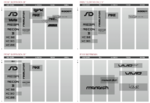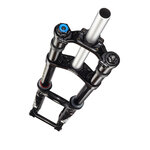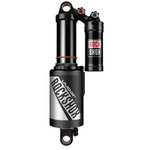Mike leroy
Active Member
What suspension is necessary for a "California motorized cycle" or "eMotorBike" capable of 45+ mph? An eMotorBike must be less than 3720 watts, according to U.S. DOT regulation. This article uses the HPC 78 volt, 3500 watt motor as a reference point. The battery tank holds two 13Ah NMC chemistry batteries. I choose the HPC Revolution based on NMC battery chemistry. Also, the tank accommodates a 26Ah battery with a 100 mile range at 20mph.
The various HPC Revoution electric bike suspensions are compared. My personal aim is explained in the post entitled "Take Control of Fast Lane When 'Bike Share' Lane is too Dangerous for Electric Bikes". Please note the HPC utilizes a swingarm, rather than a bicycle triangle. The rear axle maintains a level position with the bicycle bottom bracket (pedal axle) because shock absorber allows the frame to flex. A swingarm is more roadworthy than a traditional mountain bike rear shock system because the tire maintains better traction.
After writing this article, the traditional diamond frame/mountain bike suspension no longer makes sense to me for electric bikes. Some people may dislike the motorcycle style. For the higher speeds electric bikes enable, a swingarm suspension makes overwhelming sense. I feel foolish for not realizing how important frame design is to achieve the best full suspension. I was blinded by the features of the shocks, rather than functioning of the entire suspension system.

I choose a downhill bike because I plan to register the eMotorBike as a legal CA motorcycle. The downhill coasting speed on my 10% grade hill is over 45mph. I feel a downhill frame and suspension best suits the conditions of my road. The uphill speed limit is 35mph. I plan to only use the fast, or left-hand lane to avoid the dangers of the right-hand bike share lane. The fast lane safety strategy is used almost exclusively by motorcycles and scooters on my hill. The sanity of my bike share lane is dubious, at best.
The suspension must handle the 15 and 25mph speed bumps.
The HPC Revolution bikes are based on a modular "platform" 19 pound frame. Components can be configured to match your needs. The bike weighs less than 80 pounds fully configured with the 3500 watt motor. I also plan to buy a wheel without a motor and a 1000 watt rear hub motor, because the frame only weighs 19 pounds. Simply swap wheels for different purposes.
I plan to commute on the train with the bike. I plan to upgrade the suspension and gearing on the HPC Revolution Sport (i.e., base model). This article explains my education and reasoning process.
I write articles in installments from the comfort of my bed and iPad. I research the information before starting the article. Over the course of a week, my research becomes more extensive. I update the first post as I learn. Please check the "Last Edited" date in the bottom right hand corner of this post to know if additional content was added.
The articles are written with an iPhone app for Cost-Benefit analysis. The ten basic aspects are considered in a methodical manner. The previous paragraphs explained the "Purpose". The aspects are listed below. The Cost-Benefit approach is a useful process to resolve most difficult problems in life, including political, social, emotional or business.
The Cost-Benefit diagram is shown below. So far, the only known information is an expensive eMotorBike with a clearly defined Purpose. The aspects are rated on a scale from 1 to 5. The unknown information is rated as a "3" or average, because nothing is known. We assume the components are average. As we gain more information, we update the picture. The Cost and Purpose is rated as a "5".

Revolution 5.0-
Top Speed: 50+MPH
RockShox Boxxer front fork 203mm travel
RockShox RC2 rear shock- 8+" of frame travel
Schlumpf High Speed Drive (2.5X) Allows high speed pedaling past 50 MPH!
SRAM X9 Rear Derailluer/Shifter, 18 Speeds total
Revolution X 5.0-
Top Speed: 50+MPH
RockShox Boxxer World Cup Keronite front fork 203mm travel
RockShox VIVID RC2 rear air shock- 8+" of frame travel
Schlumpf High Speed Drive (2.5X) Allows high speed pedaling past 50 MPH!
SRAM X0 Rear Derailluer/Shifter, 20 Speeds total
The primary differences between the two suspension systems seem to be cost and weight. The amount of travel is the same. Unclear about durability, structural strength and handling characteristics.
Air springs work by using the characteristic of compressed air to resist further compression. As the spring itself is provided by the compressed air rather than a coil of metal it is much lighter; this makes their use popular in cross country designs. Another advantage of this type of fork design is that the spring rate can easily be adjusted by changing the air pressure within the fork. This allows a fork to be effectively tuned to a rider's weight. To achieve this in a coil sprung fork one would have to swap out different coils with different spring rates. However air pressure naturally controls both spring rate and preload at the same time, requiring air forks to have additional systems to adjust preload separately, adding to its complexity. Another disadvantage of air sprung forks is the difficulty in achieving a linear spring rate throughout the fork's action. As the fork compresses, the air held inside is compressed. Towards the end of the fork's travel, further compression of the fork requires ever greater force. This results in an increase in spring rate and gives the fork its progressive feel. Increasing the volume of the air inside the spring reduces this effect but the volume of the spring is ultimately limited by the need to be contained within the fork. The use of two air chambers within the system has allowed a more linear feel to air suspension, this is achieved by having a 'reserve' chamber that becomes connected to the main chamber when it reaches a certain amount of compression. Once achieved, a valve opens and effectively makes the chamber larger. By linking the two, the force needed to compress the air in the chambers is reduced which reduces the exponential spring rate feel traditionally associated with air systems when approaching the end of the suspension's travel."
The various HPC Revoution electric bike suspensions are compared. My personal aim is explained in the post entitled "Take Control of Fast Lane When 'Bike Share' Lane is too Dangerous for Electric Bikes". Please note the HPC utilizes a swingarm, rather than a bicycle triangle. The rear axle maintains a level position with the bicycle bottom bracket (pedal axle) because shock absorber allows the frame to flex. A swingarm is more roadworthy than a traditional mountain bike rear shock system because the tire maintains better traction.
After writing this article, the traditional diamond frame/mountain bike suspension no longer makes sense to me for electric bikes. Some people may dislike the motorcycle style. For the higher speeds electric bikes enable, a swingarm suspension makes overwhelming sense. I feel foolish for not realizing how important frame design is to achieve the best full suspension. I was blinded by the features of the shocks, rather than functioning of the entire suspension system.
I choose a downhill bike because I plan to register the eMotorBike as a legal CA motorcycle. The downhill coasting speed on my 10% grade hill is over 45mph. I feel a downhill frame and suspension best suits the conditions of my road. The uphill speed limit is 35mph. I plan to only use the fast, or left-hand lane to avoid the dangers of the right-hand bike share lane. The fast lane safety strategy is used almost exclusively by motorcycles and scooters on my hill. The sanity of my bike share lane is dubious, at best.
The suspension must handle the 15 and 25mph speed bumps.
The HPC Revolution bikes are based on a modular "platform" 19 pound frame. Components can be configured to match your needs. The bike weighs less than 80 pounds fully configured with the 3500 watt motor. I also plan to buy a wheel without a motor and a 1000 watt rear hub motor, because the frame only weighs 19 pounds. Simply swap wheels for different purposes.
I plan to commute on the train with the bike. I plan to upgrade the suspension and gearing on the HPC Revolution Sport (i.e., base model). This article explains my education and reasoning process.
I write articles in installments from the comfort of my bed and iPad. I research the information before starting the article. Over the course of a week, my research becomes more extensive. I update the first post as I learn. Please check the "Last Edited" date in the bottom right hand corner of this post to know if additional content was added.
The articles are written with an iPhone app for Cost-Benefit analysis. The ten basic aspects are considered in a methodical manner. The previous paragraphs explained the "Purpose". The aspects are listed below. The Cost-Benefit approach is a useful process to resolve most difficult problems in life, including political, social, emotional or business.
- Purpose
- Cost
- Risk
- Bias
- Benefits
- Ease
- Economy
- Enjoyment
- Elegance
- Endurance
- Excitement
The Cost-Benefit diagram is shown below. So far, the only known information is an expensive eMotorBike with a clearly defined Purpose. The aspects are rated on a scale from 1 to 5. The unknown information is rated as a "3" or average, because nothing is known. We assume the components are average. As we gain more information, we update the picture. The Cost and Purpose is rated as a "5".
Revolution 5.0-
Top Speed: 50+MPH
RockShox Boxxer front fork 203mm travel
RockShox RC2 rear shock- 8+" of frame travel
Schlumpf High Speed Drive (2.5X) Allows high speed pedaling past 50 MPH!
SRAM X9 Rear Derailluer/Shifter, 18 Speeds total
Revolution X 5.0-
Top Speed: 50+MPH
RockShox Boxxer World Cup Keronite front fork 203mm travel
RockShox VIVID RC2 rear air shock- 8+" of frame travel
Schlumpf High Speed Drive (2.5X) Allows high speed pedaling past 50 MPH!
SRAM X0 Rear Derailluer/Shifter, 20 Speeds total
The primary differences between the two suspension systems seem to be cost and weight. The amount of travel is the same. Unclear about durability, structural strength and handling characteristics.
"As with all shock absorbers it usually consists of two parts: a spring, and a damper. The spring may be implemented with a steel or titanium coil, compressed air, or even an elastomer. Different spring materials have different spring rates which have a fundamental effect on the characteristics of the fork as a whole. Coil sprung forks keep an approximately constant spring rate throughout their travel and act linear. The spring rate of air sprung forks however increases with travel, making them progressive. Titanium coils are much lighter but also come at a significantly increased cost. Air sprung forks are generally lighter still.Air springs work by using the characteristic of compressed air to resist further compression. As the spring itself is provided by the compressed air rather than a coil of metal it is much lighter; this makes their use popular in cross country designs. Another advantage of this type of fork design is that the spring rate can easily be adjusted by changing the air pressure within the fork. This allows a fork to be effectively tuned to a rider's weight. To achieve this in a coil sprung fork one would have to swap out different coils with different spring rates. However air pressure naturally controls both spring rate and preload at the same time, requiring air forks to have additional systems to adjust preload separately, adding to its complexity. Another disadvantage of air sprung forks is the difficulty in achieving a linear spring rate throughout the fork's action. As the fork compresses, the air held inside is compressed. Towards the end of the fork's travel, further compression of the fork requires ever greater force. This results in an increase in spring rate and gives the fork its progressive feel. Increasing the volume of the air inside the spring reduces this effect but the volume of the spring is ultimately limited by the need to be contained within the fork. The use of two air chambers within the system has allowed a more linear feel to air suspension, this is achieved by having a 'reserve' chamber that becomes connected to the main chamber when it reaches a certain amount of compression. Once achieved, a valve opens and effectively makes the chamber larger. By linking the two, the force needed to compress the air in the chambers is reduced which reduces the exponential spring rate feel traditionally associated with air systems when approaching the end of the suspension's travel."
Last edited:


